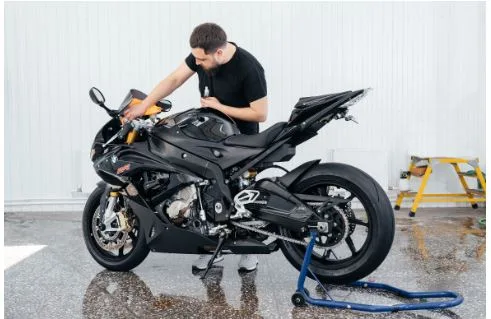Carbon Fiber Revolution: How Riders Worldwide Are Embracing Lighter, Stronger Motorcycle Parts
A Material Transforming Motorcycling
The global motorcycle industry is undergoing a material revolution. Riders, manufacturers, and custom shops are turning to carbon fiber — once exclusive to aerospace and motorsports — to reshape how motorcycles look, perform, and endure.
This isn’t a passing trend. It reflects deeper changes in rider expectations, technological possibilities, and the way motorcycles are personalized around the world.
From Race Track to Road: How Carbon Fiber Arrived
Carbon fiber first gained recognition in professional racing, where reducing weight by even small amounts could affect lap times and performance. Over time, its advantages began to appeal to everyday riders as well.
The two most compelling reasons for its adoption have been:
- Performance: A lighter bike responds more quickly to rider input, accelerates faster, and can stop with greater control.
- Durability: Carbon fiber resists stress and heat better than many conventional materials, making it suitable for components that face demanding conditions.
Advances in production methods have gradually made these parts more widely available, bringing what was once exclusive into mainstream customization.
Aesthetic Meets Engineering
Carbon fiber isn’t just about performance numbers. Its unique weave pattern and glossy finish have become design hallmarks, admired as much for their looks as their utility.
In motorcycle culture, where appearance and performance often carry equal weight, this blend of style and function explains why riders are increasingly drawn to carbon parts.
Market Momentum and Global Trends
Customization has become central to motorcycle ownership, and carbon fiber upgrades are now among the most desired aftermarket additions.
The appeal spans continents:
- Europe: Sport and touring riders favor carbon for both performance and visual refinement.
- Asia: Younger riders embrace it as a way to elevate entry-level and mid-range bikes.
- United States: Here, upgrades often reflect a mix of practicality and lifestyle expression. From BMW Motorcycle Accessories to aerodynamic winglets for sport models, the market shows a strong appetite for parts that combine utility with individuality.
Expert Voices: Inside the Carbon Fiber Movement
Industry observers note a clear shift in expectations. A decade ago, most riders associated carbon fiber solely with racing or high-end builds. Today, it has become a sought-after upgrade across a wide range of motorcycles.
This change has been supported by more advanced production methods, including precision cutting and autoclave processing, which improve both consistency and quality. At the same time, many aftermarket components are designed as direct bolt-on replacements, making them accessible to everyday riders without requiring extensive modifications.
Beyond Performance: The Sustainability Angle
Sustainability is an emerging part of the carbon fiber story. While the production process remains energy-intensive, the material’s strength and longevity can extend the lifespan of parts, reducing the frequency of replacements.
Researchers and manufacturers are also exploring improved resins and potential recycling techniques. These developments could make carbon fiber not only a high-performance choice but a more responsible one in the long term.
The Rider Experience: On the Road with Carbon Fiber
For many riders, the switch to carbon fiber components changes how the motorcycle feels in motion.
- Agility: Less weight enhances responsiveness during turns and in city traffic.
- Comfort: Vibration control and heat resistance support longer, smoother rides.
- Identity: The distinctive look of carbon fiber transforms a motorcycle into a more personal statement.
This combination of functional and emotional benefits explains why riders often describe carbon upgrades as more than just parts — they see them as part of the riding experience itself.
Global Voices: Why Carbon Fiber Resonates
Across different regions, the story of carbon fiber reflects both shared and unique perspectives:
- In Asia, young riders view it as a way to stand out in crowded urban settings.
- In Europe, it is valued for durability and refined design.
- In North America, it embodies a blend of lifestyle, individuality, and performance.
Though the motivations vary, the common thread is clear: carbon fiber allows riders to push their machines closer to the ideal balance of form and function.
What’s Next for the Carbon Fiber Revolution?
Carbon fiber is expected to play a growing role in the industry’s future. Lighter materials could prove especially important for electric motorcycles, where reducing weight is essential to offset heavy batteries.
Developments in aerodynamics and hybrid materials may expand possibilities further, combining carbon fiber with other composites or even electronic integrations. Manufacturers are already testing new approaches that could redefine performance, safety, and design over the next decade.
A Future Built on Lighter, Stronger Choices
The motorcycle industry is moving into a new era. Carbon fiber, once the reserve of professional racers, is becoming a practical, stylish, and sometimes sustainable choice for riders everywhere.
For enthusiasts, it delivers agility, comfort, and a distinct identity. For the industry, it represents innovation and adaptability.
The future of motorcycling may not be written in steel or aluminum alone. Increasingly, it will be woven in carbon fiber — shaping lighter, stronger, and smarter rides for the roads ahead.





